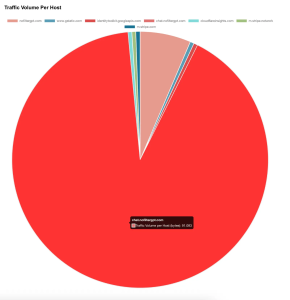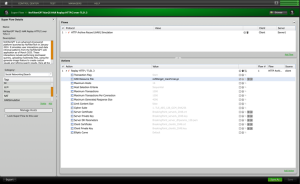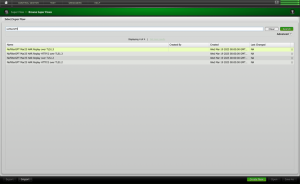Feed aggregator
Fraunhofer IAF develops semi-automated manufacturing process for cost-efficient resonantly tunable quantum cascade laser modules
10-octave linear-in-pitch VCO with buffered tri-wave output

Frequent contributor Nick Cornford recently assembled an ensemble of cool circuit designs incorporating linear-in-pitch VCOs (LPVCOs).
- “A pitch-linear VCO, part 1: Getting it going”
- “A pitch-linear VCO, part 2: taking it further”
- “Revealing the infrasonic underworld cheaply, Part 1”
- “Revealing the infrasonic underworld cheaply, Part 2”
These elegant and innovative designs (standard fare for Nick’s contributions) were perfectly adequate for their intended applications. Nevertheless, it got me wondering how difficult it would be to implement an LPVCO with a range covering the full 10-octave audio spectrum, from 20 Hz to 20 kHz. I even decided to try for extra credit by going for a tri-wave output suitable for direct drive of one of Nick’s famous squish-diode sine converters. Figure 1 shows the result.

Figure 1 An LPVCO with 10-octave (20 Hz to 20 kHz) tri-wave output comprises antilog pair Q1 and Q2, two-way current mirror Q3 and Q4, integrator A1b, comparator A1a, and buffer A1c. Resistors R1 and R2 are precision types, and T1 is a Vishay NTCSC0201E3103FLHT (inhale!).
Wow the engineering world with your unique design: Design Ideas Submission Guide
Vin is scaled by the tempco-compensating voltage divider, ((R1+T1)/R2 + 1) = 28:1, and applied to the Q1 and Q2 antilog pair, where Q1 level shifts and further temperature compensates it. Then, with the help of buffer A1c, it’s antilogged and inverted by Q2 to produce Ic2 = 2(2Vin) µA = 1 µA to 1 mA for Vin = 0 to 5v.
From there, it goes to the two-way current mirror: Q3 and Q4. A description of how the TWCM works can be found here in “A two-way mirror—current mirror that is.”
The TWCM passes Ic2 through to the integrator A1b if comparator A1a’s output is zero, and mirrors (inverts) it if A1a’s output is high. Thus, A1b ramps up if A1a’s output is at 0v, and down if it’s at 5v, resulting in sustained oscillation.
The C1 timing ramp has a duration in each direction ranging from 25 ms (for Vin = 0) to 25 µs (for Vin = 5v). The triangular cycle will therefore repeat at Fosc = 2(2Vin)µA/(25nCb)/2 = 20(2(2Vin) ) Hz.
So, there’s the goal of a tri-wave LPVCO with an output span of 20 Hz to 20 kHz centered at 640 Hz, and it wasn’t so terribly messy to get there after all!
My thanks go to Nick Cornford for introducing the LPVCO to Design Ideas (DIs), and to Christopher Paul and Andy I for their highly helpful simulations and constructive criticisms of my halting steps to temperature-compensating antilogging circuits. I also thank editor Aalyia Shaukat for her DI environment that makes such teamwork possible for a gang of opinionated engineers, and mostly accomplished without actual bloodshed!
Mostly.
Stephen Woodward’s relationship with EDN’s DI column goes back quite a long way. Over 100 submissions have been accepted since his first contribution back in 1974.
Related Content
- Seven-octave linear-in-pitch VCO
- A pitch-linear VCO, part 1: Getting it going
- A pitch-linear VCO, part 2: taking it further
- Revealing the infrasonic underworld cheaply, Part 1
- Revealing the infrasonic underworld cheaply, Part 2
The post 10-octave linear-in-pitch VCO with buffered tri-wave output appeared first on EDN.
Infineon OptiMOS 80 V and 100 V, and MOTIX enable high-performing motor control solutions for Reflex Drive’s UAVs
Reflex Drive, a deep tech startup from India has selected power devices from Infineon Technologies AG for its next-generation motor control solutions for unmanned aerial vehicles (UAVs). By integrating Infineon’s OptiMOS 80 V and 100 V, Reflex Drive’s electric speed controllers (ESCs) achieve improved thermal management and higher efficiency, enabling high power density in a compact footprint. Additionally, the use of Infineon’s MOTIX IMD701 controller solution which combines the XMC1404 microcontroller with the MOTIX 6EDL7141 3-phase gate driver IC delivers compact, precise, and reliable motor control. This enables improved performance, greater reliability, and longer flight times for UAVs.
“Our partnership with Reflex Drive is an important contribution to our market launch strategy and presence in India,” says Nenad Belancic, Global Application Manager Robotics and Drones at Infineon. “Our partner has proven its expertise with numerous customers who have obtained aviation certifications. In addition, the company has presented its innovative technologies enabled by Infineon systems at important international industry events.”
“Our collaboration with Infineon has led to significant advances in UAV electronics,” says Amrit Singh, Founder of Reflex Drive. “We believe drones have the potential to transform industries, from agriculture to logistics, and with Infineon’s devices, we can help drive this transformation at the forefront.”
Reflex Drives’s ESCs with field-oriented control (FOC) offer improved motor efficiency and precise control, while its high-performance BLDC motors are designed for optimized flight control and enable predictive maintenance of drive systems. Weighing only 180 g and with a compact volume of 120 cm³, the ESCs can deliver continuous power output of 3.8 kW (12S/48 V, 80 A continuous). Due to their lightweight design, robust power output, and consistent FOC control – even under demanding weather conditions – make them ideal for motors in the thrust range from 15 to 20 kg. Therefore, they are particularly suitable for drone applications in the fields of agricultural spraying technology, seed dispersal, small-scale logistics, and goods transport.
The post Infineon OptiMOS 80 V and 100 V, and MOTIX enable high-performing motor control solutions for Reflex Drive’s UAVs appeared first on ELE Times.
Seeing inside entry-level audiophile desire: Monoprice’s Liquid Spark Headphone Amplifier
 My audio gear
My audio gear
Back in July 2019, I told you about the combo of Massdrop’s x Grace Design Standard DAC:


and its companion Massdrop Objective 2 Headphone Amp: Desktop Edition (Massdrop is now just Drop, by the way, and is now owned by Corsair):


that I’d recently acquired for listening to computer-sourced audio over headphones in a quality-upgraded fashion beyond just the DAC (and amp-fed headphone jack) built into my Mac. That same two-device stack:


remains on my desk and to my right to this very day, albeit subsequently joined by an even higher quality balanced audio stack to my left:

combining a Topping D10 Balanced DAC:

and a Drop + THX AAA 789 Linear Headphone Amplifier:


But I digress. Today’s dissection showcase is of none of these. Instead, I’ll be analyzing the guts of the Monolith by Monoprice Liquid Spark Headphone Amplifier by Alex Cavalli:


It’s comparable in size to the Massdrop Objective 2 Headphone Amp: Desktop Edition I mentioned at the beginning of the writeup:

And what about a companion digital-to-analog converter? That’s a story all by itself. It originally had one, the unsurprisingly named “Monolith by Monoprice Liquid Spark DAC by Alex Cavalli”:

based on an Asahi Kasei Microdevices (AKM) Semiconductor DAC chip. However, in October 2020, just as COVID was in general throttling the tech economy, audio equipment suppliers got a double-whammy: a massive three-day fire at AKM’s semiconductor facility in Japan, which clobbered its output. Some AKM customers, such as Fiio and Schiit (the latter, for example, redesigning and renaming its Modi 3 DAC as the Modi 3e, with “e” short for ESS Technology), redesigned their systems to use chips from other suppliers instead. Others, like Monoprice, threw in the towel. That said, since the Monoprice Liquid Spark headphone amp has conventional RCA (unbalanced) analog line inputs, you can use it with any standard DAC.
A bit of background infoA few definitions before proceeding with the dissection. “Monolith” is Monoprice’s audio products brand. Alex Cavalli is a now-retired, well-known audio amplifier designer who, in addition to selling both self-branded Cavalli Audio equipment (now repaired by Avenson Audio since his retirement) and gear branded by Monoprice (obviously) and Massdrop/Drop, also published complete design documentation sets for others to use in building their own gear, DIY style. Alex is a contemporary of another audio amplifier “wizard” whose name may be more familiar to you: Nelson Pass.
And finally, why do I categorize it as being for “entry-level audiophiles”? The feature set, for one thing. I’ve already noted that it doesn’t offer balanced inputs and outputs, for example, the magnitude-of-benefits of which are debatable, anyway. That said, unlike the Massdrop Objective 2 Headphone Amp: Desktop Edition, it does include preamp outputs, the benefit of which I’ll elaborate on shortly. And its performance is nothing to sneeze at:
- Manufacturer-published spec sheet (PDF)
- Manufacturer-published test measurement graphs (PDF)
- Independently published testing results (Audio Science Review)
- Independently published testing results (Super Best Audio Friends)
And the price, although that’s an imperfect-at-best barometer of quality. That said, Schiit’s current high-end solid-state Mjolnir 3 headphone amp (the company also sells tube-based products) goes for $1,199-$1,299, depending on color. Conversely, when the Liquid Spark Headphone Amplifier was introduced in 2018 (a year after Alex Cavalli announced his retirement, interestingly), Monoprice sold it for $99. Its list price is now $129. But (in explaining how I first came across it) I’ve long subscribed to Monoprice’s periodic promotional emails, and back in March of last year, I stumbled across a smokin’ deal; $32.49 each plus a further 25%-off discount. I bought two at $50.29 total (with tax), one for a buddy’s birthday, the other for me.
What I’ll be taking apart today is neither of these devices, however. Last October, while searching for a Liquid Spark DAC mate to my headphone amplifier, I stumbled across “as-is” Liquid Spark amps on eBay for $29.99 plus tax and $9.99 for shipping. The seller notes said:
Pulled from a professional working environment. Tested for power, no further testing was done. Due to lack of knowledge and having the proper equipment to fully test these units, we are selling AS-IS for parts/not working. Unit shows some signs of scuffs/scratches all around the unit. Please refer to the photos for more detailed information on the cosmetic condition.
As I’ve mentioned (and exemplified) many times before, such “for parts only” listings are perfect for teardown purposes. I ended up getting one for $20.99 (plus the aforementioned sales tax and shipping). I’m not sure how the seller “tested for power”, since it didn’t come with the requisite “wall wart”. And as you may have already noticed from the back panel “stock photo” shown earlier, it’s an uncommon one, outputting 36V at 1.25A min (that said, at least it’s got a DC output; Schiit’s are all just AC transformers).
OverviewI have no idea if this one actually works, and I’m not going to chance zapping my personal amplifier’s functional PSU to find out. That said, here it is in all its cosmetically imperfect glory, as usual accompanied by a 0.75″ (19.1 mm) diameter U.S. penny for size comparison purposes (the unit has dimensions of 4.6″ x 3.7″ x 1.5″/117 x 94 x 38 mm and weighs 9.6 oz./271g):

Left-to-right are the power switch, a ¼” TRS headphone jack, a 3-or-6 dB gain switch (to accommodate headphones of varying impedance), and a rotary volume control knob. Now, about that back panel (following up on my earlier “teaser” comment about the RCA output set):

Most headphone amps in this price range have unbalanced RCA inputs, but their only output is an unbalanced TRS headphone jack (of varying diameter) up front. But this one also has a pair of unbalanced RCA outputs. And they’re not just simple line level pass-throughs, either; they route through the internal preamplifier first, although they (obviously) then bypass the headphone amplifier circuitry. Why’s this nice? Well, you can connect them to an external power amplifier to drive a set of speakers from the same audio source. And, because the preamp is still in the loop, the headphone amp’s volume control manages speaker volume, too.

The one thing I don’t know (and haven’t tested with my unit) yet, and the user manual doesn’t clarify, is whether the two output sets operate simultaneously or (as is the case with Schiit’s device equivalents) in a one-or-the other fashion. Said another way, when you plug in some “cans”, does this also mute the sound that would otherwise come out the connected speakers?
Onward: the left and right sides:


The top:

and bottom:

complete with a label closeup:

I admittedly enjoyed fondling this device, both in an absolute sense and relative to the scores of predominantly plastic-based products I’ve taken apart in the past (and will undoubtedly continue to do so in the future). It’s heft…the solidity of its all-metal construction…very nice!
Teardown timeSpeaking of that all-metal construction, let’s start by getting the front panel off, starting with the Torx head screws on both ends:

Part of the way there…

Let’s see what’s behind that volume knob, which was snugly attached but pulled off after a bit of muscle-powered coercion:

Unscrew the nut, remove the washer:

and this part of the total task is successfully completed:


Check out that gloriously thick and otherwise solid PCB!

Now for the back panel. Six screws there and another one below:

And the panel-still-attached PCB slides out the rear:


Voila!

Jumping forward to the future for a moment, I went back and perused the product page after the teardown-in-progress and found this, which I hadn’t noticed earlier:

It wasn’t surprising. It was, conversely, validating. Truth be told, even before I took this amp apart, I’d suspected I’d encounter a discretes- (vs op amp-) based design. And when I saw the horde of tiny ICs scattered all over the top of the PCB, my in-advance hunch was validated.
Before diving in, let’s first flip the PCB over and take a look at the other side:

Not as much to see here, aside from this closeup:

The largest two ICs shown, which curiously don’t have their own PCB-marking notations, versus the resistors and capacitors surrounding them (perhaps the marks are underneath the chip packages) are labeled as follows, along with what I think is a STMicroelectronics logo:
071I
GZ229
Any idea what they are, readers? Back to the front for a close-up of the most interesting section:

The largest packaged parts on this side are a mix of what I believe to be QJ423 p-channel and QJ444 n-channel MOSFETs, both curiously identified in online specs as intended for automotive applications. And look, Alex even brands his PCBs!

I’ll close with a few side views of the solid-construction circuit board:



And that’s all I’ve got for you today. I’ll hold onto the disassembled device for a while in case you have any specific questions on the markings on some of the other, tinier ICs and/or passives. And, as always, I welcome your thoughts in the comments. Bonus points for anyone who is able to dig up an Alex-authored DIY schematic that corresponds to this design!
—Brian Dipert is the Editor-in-Chief of the Edge AI and Vision Alliance, and a Senior Analyst at BDTI and Editor-in-Chief of InsideDSP, the company’s online newsletter.
Related Content
- High quality and lossy: Audio upgrades don’t need to be costly
- FiiO transitions: Technology evolutions
- Putting an audiophile “tweak” to the test
- Decoding and virtualization bring surround sound to the masses
- How to stop worrying and love compressed audio
- Microphones: An abundance of options for capturing tones
The post Seeing inside entry-level audiophile desire: Monoprice’s Liquid Spark Headphone Amplifier appeared first on EDN.
New AI networking switch breaks the 100-Tbps barrier

The need for unified networks serving artificial intelligence (AI) training and inference is reaching an unprecedented scale. Broadcom’s answer: The Tomahawk 6 switch delivers 102.4 Tbs of switching capacity in a single chip, doubling the bandwidth of any Ethernet switch currently available on the market.
AI clusters—scaling from tens to thousands of accelerators—are turning the network into a critical bottleneck with bandwidth and latency as major limitations. Tomahawk 6, boasting 100G/200G SerDes and co-packaged optics (CPO) technology, breaks the 100-Tbps barrier while facilitating a flexible path to the next wave of AI infrastructure.

Figure 1 Tomahawk 6’s two-tier network structure, instead of a three-tier network, leads to fewer optics, lower latency, and higher reliability. Source: Broadcom
Ram Velaga, senior VP and GM of Core Switching Group at Broadcom, calls Tomahawk 6 not just an upgrade but a breakthrough. “It marks a turning point in AI infrastructure design, combining the highest bandwidth, power efficiency, and adaptive routing features for scale-up and scale-out networks into one platform.”
First, the Tomahawk 6 family of switches includes an option for 1,024 100G SerDes on a single chip, allowing designers to deploy AI clusters with extended copper reach. Moreover, Broadcom’s 200G SerDes provides the longest reach for passive copper interconnect, facilitating high-efficiency, low-latency system design with greater reliability, and lower total cost of ownership (TCO).
Second, Tomahawk 6 is also available with co-packaged optics, which lowers power and latency while reducing link flaps. Tomahawk 6’s CPO solution is built upon Broadcom’s CPO versions of Tomahawk 4 and Tomahawk 5.
Third, Tomahawk 6 incorporates advanced AI routing capabilities that encompass features like advanced telemetry, dynamic congestion control, rapid failure detection, and packet trimming. These features enable global load balancing and adaptive flow control while supporting modern AI workloads, including mixture-of-experts, fine-tuning, reinforcement learning, and reasoning models.

Figure 2 Cognitive Routing 2.0 in Tomahawk 6 features advanced telemetry, dynamic congestion control, rapid failure detection, and packet trimming. Source: Broadcom
The capabilities outlined above provide essential advantages for hyperscale AI network operators. They also allow cloud operators to dynamically partition their XPU assets into the optimal configuration for different AI workloads. Broadcom claims that Tomahawk 6 meets all networking demands for emerging 100,000 to one million XPU clusters.

Figure 3 Tomahawk 6 can accommodate up to 512 XPUs in a scale-op cluster. Source: Broadcom
While Tomahawk 5 has proven itself in large GPU clusters, Tomahawk 6 takes it a step further in terms of bandwidth, SerDes speed and density, load balancing, and telemetry. Tomahawk 6, compliant with the Ultra Ethernet Consortium, also supports arbitrary network topologies, including scale-up, Clos, rail-only, rail-optimized, and torus.
Related Content
- Solving AI’s Power Struggle
- AI Trolls for Data Center Woes
- Broadcom Throws Programmable Switch
- Are we ready for large-scale AI workloads?
- Ethernet adapter chips aim to bolster AI data center networking
The post New AI networking switch breaks the 100-Tbps barrier appeared first on EDN.
Склад Наглядової ради КПІ ім. Ігоря Сікорського
3 червня 2025 року, Міністерство освіти і науки України затвердило новий склад Наглядової ради КПІ ім. Ігоря Сікорського.
КПІ готуватиме фахівців з державного гарантування якості в ОПК
КПІ ім. Ігоря Сікорського співпрацюватиме з Міністерством оборони України щодо підготовки фахівців з державного гарантування якості в ОПК
Indium Corp joins Virginia Tech’s Center for Power Electronics Systems consortium
Navitas and BrightLoop partners on next-gen hydrogen fuel-cell charging
Вітаємо Володимира Угольникова з ювілеєм!
12 травня виповнилося 90 років Володимиру Юхимовичу Угольникову – донедавна керівникові сектору акредитації навчально-методичного відділу КПІ ім. Ігоря Сікорського.
The analog-centric timing world takes a digital turn

The analog-based timing semiconductor world, comprising crystals and phase-lock loops (PLLs), is facing a conundrum. While crystals provide higher performance at lower frequencies, PLLs accommodate higher frequencies with lower performance. An Irvine, California-based timing startup claims to have an answer to this conundrum. It digitally synthesizes timing signals using CMOS technology, thereby replacing legacy analog chains.
Read the full story at EDN’s sister publication, Planet Analog.
Related Content
- It’s time to advance your clock
- Programmable clock, the universal timing solution?
- Moving Time: Bringing Quantum Clocks Out of the Lab
- A Planet Analog Primer: A Clock For Every Timing Need
- RTC design: Real-time clocks still matter in automation, IoT applications
The post The analog-centric timing world takes a digital turn appeared first on EDN.
SuperLight partners with ProCareLight to expand presence in Iberian market
Riber receives order from Asia for MBE 412 research system
GMSL video link’s quest to become open automotive standard

The Gigabit Multimedia Serial Link (GMSL) technology of Analog Devices Inc. (ADI) is finally heading down the standardization path with the inception of the OpenGMSL Association, a non-profit entity joined by an automotive OEM, tier 1 suppliers, semiconductor companies, and several test and measurement firms.
GMSL—a SerDes technology for automotive applications like advanced driver assistance systems (ADAS), touchscreen infotainment, and in-vehicle connectivity—facilitates high-resolution video links while supporting data transfer speeds of up to 12 Gbps. ADI claims to have shipped more than 1 billion GMSL chips for automotive-grade platforms.

Figure 1 GMSL is a point-to-point serial link technology dedicated to video data transmission; it was originally designed for automotive camera and display applications. Source: ADI
OpenGMSL Association aims to turn this automotive SerDes technology into an open standard for in-vehicle connectivity. “As automotive architectures evolve to meet the growing demands of in-vehicle communication, networking and data transfer, it is critical that the industry has access to open global standards such as OpenGSML to enable ecosystem-led innovation,” said Fred Jarrar, VP and GM of Power and ASIC Business Unit at indie Semiconductor, a member of OpenGMSL Association.
Among the test and measurement companies joining the OpenGMSL Association are Keysight Technologies, Rohde & Schwarz, and Teledyne LeCroy. These in-vehicle network test outfits will help OpenGMSL in facilitating the development and deployment of interoperable and reliable automotive systems through a standardized, open ecosystem for in-vehicle connectivity.
Hyundai Mobis, which has used the GMSL technology in the Korean OEM’s vehicles for many years, has also joined the initiative to standardize GMSL. Then, there is GlobalFoundries (GF), pitching its 22FDX, 12LP+ and 40LP process technologies for GMSL chips targeted at next-generation automotive applications.

Figure 2 OpenGMSL aims to transform SerDes transmission of video and/or high-speed data as an open standard across the automotive ecosystem. Source: ADI
Next-generation automotive platforms like ADAS heavily rely on high-quality video data to make critical, real-time decisions that improve driver safety and reduce accidents. Likewise, touchscreen infotainment systems demand high-speed and low-latency connectivity for seamless, immersive user experiences.
OpenGMSL aims to accelerate innovation across these automotive platforms by cultivating a standardized, open ecosystem for in-vehicle connectivity. ADI is betting that an open standard for video and/or high-speed data transmission built around its GMSL technology will bolster autonomous driving, ADAS, and infotainment applications, and its own standing in the automotive market.
Related Content
- Machine-Vision Architectures for Automotive Apps
- ADI’s GMSL technology eyes a place on ADAS bandwagon
- Using GMSL SerDes Devices in a Dual Automotive (ECU) Application
- Complex but necessary technology for automotive: Serial links re-visited
The post GMSL video link’s quest to become open automotive standard appeared first on EDN.
Power amplifiers that oscillate—deliberately. Part 1: A simple start.

Editor’s Note: This DI is a two-part series.
In Part 1, Nick Cornford deliberately oscillates the TDA7052A audio power amplifier to produce a siren-like sound and, given the device’s distortion characteristics, a functional Wien bridge oscillator.
In Part 2, Cornford minimizes this distortion and adds amplitude control to the circuit.
When audio power amplifiers oscillate, the result is often smoke, perhaps with a well-cooked PCB and a side order of fried tweeter. This two-part Design Idea (DI) shows some interesting ways of (mis-)using a common power amp to produce deliberate oscillations of varying qualities.
That device is the TDA7052A, a neat 8-pin device with a high, voltage-controllable gain, capable of driving up to a watt or so into a bridge-tied load from its balanced outputs. The TDA7056A is a better-heatsinked (-heatsunk?) 5-W version. (That “A” on the part number is critical; the straight TDA7052 has slightly more gain, but no control over it.) The TDA7052B is an uprated device with a very similar spec, and the TDA7056B is the 5-W counterpart of that. But now the bad news: they are no longer manufactured. Some good news: they can easily be found online, and there is also a Taiwanese second source (or clone) from Unisonic Technologies Ltd.
A simple circuit’s siren song
For the best results, we’ll need to check out some things that don’t appear on the data sheets, but let’s cut straight to something more practical: a working circuit. Figure 1 shows how the balanced, anti-phase outputs help us build a simple oscillator based on the integrator-with-thresholds architecture.
Figure 1 A minimalist power oscillator, with typical waveforms.
This circuit has just three advantages: it’s very simple, reasonably efficient, and, with a connected speaker, very loud. Apart from those, it has problems. Because of the amp’s input loading (nominally 20k) and the variation of drive levels with different loads, it’s hard to calculate the frequency precisely. (The frequency-versus-R1 values shown are measured ones.) R2 is needed to reduce loading on the timing network, but must leave enough gain for steady operation. (A series capacitor here proved unnecessary, as the internally biased input pin is being over-driven.) Its efficiency is due to the amp’s output devices being run in saturation: with no extra heatsinking, the (DIL-8) package warms by ~15°C when driving into an 8 Ω speaker. The square wave produced is somewhat asymmetrical, though good enough for alarm use.
Figure 1 shows a 5-V supply. Raising that to 12 V made only one change to the performance: the output became very, very loud. And it drew around an amp with a 10 Ω load. And it could do with a heatsink. And a TDA7056A/B rather than a ’52.
The Vcon input on pin 4 is not used. Left open, it floats at ~1.14 V, giving the device a measured gain of around 25 dB. Taking it close to ground inhibits operation, so a bare-drain MOSFET hooked on here can give on/off control. Taking it higher gives full gain, with a shift in frequency. If that is not important (and, in this context, why should it be?), logic control through a 22k resistor works fine. When inhibited, the device still draws 8–10 mA.
Feeding Vcon with varying analog signals of up to a few tens of hertz can produce interesting siren effects because changes in gain affect the oscillation frequency. But for a proper siren, it would be better to generate everything inside a small micro and use an H-bridge of (less lossy) MOSFETs to drive the speaker with proper square waves. (We’ve all heard something like that on nearby streets, though hopefully not in our own.)
Fancy sound effects apart, any power amp with a suitable input structure, enough gain, and balanced (BTL) outputs should work well in this simplest of circuits.
Determining distortion
So much for simplicity and raw grunt. Now let’s take a look at some of the device’s subtleties and see how we can use those to good effect. Distortion will be critical, but the data sheet merely quotes 0.3 to 1% under load, which is scarcely hi-fi. If we remove the load, things look much healthier. Figure 2 shows the unloaded output spectrum when the input was driven from an ultra-low-distortion oscillator, at levels trimmed to give 0 dBu (2.83 V pk-pk) and -20 dBu at the output with a device gain fixed at around 25 dB (Vcon was left open, but decoupled).

Figure 2 The TDA7052A’s output spectra for high and low output levels, taken under ideal conditions and with no output load.
Further tests with various combinations of input level and device gain showed that distortion is least for the highest gains—or smallest gain-reductions—and lowest levels. With outputs less than ~300 mVpk–pk (~-18 dBu) and gains more than 10 dB, distortion is buried in the noise.
That’s unloaded. Put a 10 Ω resistive load across the outputs, and the result is Figure 3.

Figure 3 Similar spectra to Figure 2, but with a 10-Ω output load.
That looks like around -38 dB THD for each trace, compared with better than -60 and -70 dB for the unloaded cases. All this confirms that the distortion comes mainly from the output stages, and then only when they are loaded.
A working one-chip sine-wave oscillator—
This means that we have a chance to build a one-chip Wien bridge audio oscillator, which could even drive a power load directly while still having lower distortion than the average loudspeaker. Let’s try adding a Wien frequency-selective network and a simple gain-control loop, which uses Zener diodes to sense and stabilize the operating level, as in Figure 4.

Figure 4 A simple gain control loop helps maintain a constant output amplitude in a basic Wien bridge oscillator.
The Wien network is R1 to R4 with C1 and C2. This has both minimum loss (~10 dB) and minimum phase shift (~0°) at f = 1 / 2π C2 (R2 + R4), which gives the oscillation frequency when just enough positive feedback is added. When the amplitude is large enough, Zeners D1 and D2 start to conduct on the peaks, progressively turning Q1 on, thus pulling U1’s Vcon pin lower to reduce its gain enough to maintain clean oscillation.
C3 smooths out the inevitable ripple and determines the control loop’s time-constant. R5 minimizes U1’s loading of the Wien network while C3 blocks DC, and R6 sets the output level. The unloaded spectra for outputs of 0 and -10 dBV are shown in Figure 5.
 Figure 5. The spectra of Figure 4’s oscillator for 0 and -10 dBV outputs with no load.
Figure 5. The spectra of Figure 4’s oscillator for 0 and -10 dBV outputs with no load.
—that has problems
While those spectra are half-decent, with THDs of around -45 and -60 dB (or ~0.1% distortion), they are only valid for a given temperature and with no extra load on the output. Increasing the temperature by 25°C halves the output amplitude—no surprise, given the tempcos of the diodes and the transistor. And those 3.3-V Zeners have very soft knees, especially at low operating currents, so they are better regarded as non-linear resistors than as sharp level-sensors.
Adding a 10-Ω resistor as a load—and tweaking R6 to readjust the levels—gives Figure 6.

Figure 6 Similar spectra to Figure 5’s but with the output loaded with 10 Ω.
THD is now around -30 dB, or 3%. Unimpressive, but comparable with many speakers’ distortions, and actually worse than the data-sheet figures for a loaded device.
So, we must conclude that while a one-chip sinusoidal oscillator based on this is doable, it isn’t very usable, and further tweaks won’t help much. We need better amplitude control, which means adding another chip, perhaps a dual op-amp, and that is what we will do in Part 2.
—Nick Cornford built his first crystal set at 10, and since then has designed professional audio equipment, many datacomm products, and technical security kit. He has at last retired. Mostly. Sort of.
Related Content
- Ultra-low distortion oscillator, part 1: how not to do it.
- Ultra-low distortion oscillator, part 2: the real deal
- Distortion in power amplifiers, Part IV: the power amplifier stages
- A pitch-linear VCO, part 1: Getting it going
- A pitch-linear VCO, part 2: taking it further
The post Power amplifiers that oscillate—deliberately. Part 1: A simple start. appeared first on EDN.
Network Traffic Analysis of NoFilter GPT: Real-Time AI for Unfiltered Conversations
NoFilter GPT is a cutting-edge conversational AI built to deliver unfiltered, bold, and authentic interactions. It offers different modes for different tasks: Raw Mode delivers candid, no-nonsense dialogue; Insight Mode explores complex topics with sharp analysis; and Reality Check Mode debunks misinformation with brutally honest takes. NoFilter GPT is designed for users who value clarity, directness and intellectual integrity in real-time conversations.
Network Traffic AnalysisThe ATI team in Keysight has analyzed the network traffic of NoFilter GPT and found some interesting insights that can help researchers optimize performance and enhance security. This analysis was conducted using HAR captures from a web session. NoFilter GPT operates with standard web protocols and relies on secure TLS encryption for communication.
Overall AnalysisWe have performed extensive user interactions with the NoFilter GPT web application. The captured traffic was completely TLS encrypted. We have further analyzed the traffic based on host names.

Figure 1: Request-Response count per host
In the figure above we can observe the majority of request-response interactions were observed with nofiltergpt.com, handling core AI functions like chat and image generation. Additionally, NoFilterGPT related host, chat.nofiltergpt.com manage AI chat, image generation, and token-based request authentication, while other external hosts primarily serve static assets and analytics.

Figure 2: Cumulative payload per host
The diagram above shows that the host chat.nofiltergpt.com has the maximum cumulative payload followed by nofiltergpt.com. The rest of the hosts are creating smaller network footprints.
Analyzing EndpointsBy examining the HAR file, we gain a detailed view of the HTTP requests and responses between the client and NoFilter GPT’s servers. This analysis focuses on critical endpoints and their roles in the platform’s functionality.
Chat CompletionEndpoint: https://chat.nofiltergpt.com/run/nofilterai/controller5?identifier…

- Method: POST
- Purpose: This is the actual request that sends user input to the chat model and receives a response.
- Request Headers:
- Content-Type: application/json
- Accept: */* (Accepts any response type, indicating a flexible API for logging events.)
- Origin: https://nofiltergpt.com (Ensures requests originate from NoFilterGPT’s platform)
- Request Payload: Base64-encoded JSON containing user message, system prompt, temperature, etc.
- Response Status: 200 OK (successful session creation)
This triggers a response from the model.

- Method: OPTIONS
- Purpose: This is a CORS ( Cross-Origin Resource Sharing ) preflight request automatically sent by the browser before the POST request.
- Request Payload: None
The server responds with headers indicating what methods and origins are allowed, enabling the browser to safely send the POST.
Image Generation- Endpoint: https://chat.nofiltergpt.com/media/generate2.php

- Method: POST
- Purpose: Sends an image generation prompt to the server.
- Request Headers:
- Content-Type: application/json
- Accept: */* (Accepts any response type, indicating a flexible API for logging events.)
- Request Payload: JSON with token, prompt, width, height, steps, sampler, etc.
- Response Status: 200 OK (successful session creation)
This generates and returns an image based on the prompt and settings.

- Method: OPTIONS
- Purpose: Browser-initiated CORS preflight checks to see if the server will accept the POST request
- Request Payload: None
Gets permission from the server to proceed with the actual POST request.
NOTE: While NoFilterGPT can be useful it is a prohibited tool by many companies and government entities. Policy and technical systems must be in place to prevent usage, and it is vital to confirm this via test using BreakingPoint. These tests help validate the security measures and help organizations prevent accidental or malicious use of the platform.
NoFilterGPT Traffic Simulation in Keysight ATIAt Keysight Technologies Application and Threat Intelligence (ATI), since we always try to deliver the hot trending application, we have published the NoFilter GPT application in ATI-2025-05 which simulates the HAR collected from the NoFilter GPT web application as of March 2025 including different user actions like performing text-based queries, uploading multimedia files, using the generate image feature to create custom visuals and refining search results. Here all the HTTP transactions are replayed in HTTP/2 over TLS1.3.

Figure 3: NoFilterGPT Mar25 HAR Replay HTTP/2 over TLS1.3 Superflow in BPS
The NoFilterGPT application and its 4 new Superflows as shown below:

Figure 4: NoFilterGPT App and its Superflows in BPS
Leverage Subscription Service to Stay Ahead of AttacksKeysight’s Application and Threat Intelligence subscription provides daily malware and bi-weekly updates of the latest application protocols and vulnerabilities for use with Keysight test platforms. The ATI Research Centre continuously monitors threats as they appear in the wild. Customers of BreakingPoint now have access to attack campaigns for different advanced persistent threats, allowing BreakingPoint Customers to test their currently deployed security control’s ability to detect or block such attacks.
The post Network Traffic Analysis of NoFilter GPT: Real-Time AI for Unfiltered Conversations appeared first on ELE Times.
UK Electronics Skills Foundation launches Government-funded Semiconductor Skills, Talent and Education Programme
Chill Day КПІ
Нещодавно відбувся Chill Day КПІ — теплий та яскравий день, присвячений завершенню весни. Його головною метою було створити чудову атмосферу для відпочинку, спілкування та перезавантаження.
Ніна Опанасівна Вірченко: "Україна – понад усе!"
Легенді української математики та жінці, яка стала одним із символів незламності українського духу, Ніні Опанасівні Вірченко 5 травня виповнилося 95 років.








